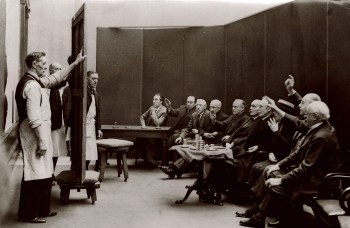Alfred Hardiman RA (1891 - 1949)
RA Collection: People and Organisations
Born in London, Alfred Hardiman first trained as an artist at the Central School of Arts and Crafts, and the Royal College of Art, where other sculptors included future Academicians William McMillan and Charles Wheeler.
He entered the Royal Academy Schools in 1915 but his studies were curtailed by World War I. After the cessation of hostilities Hardiman resumed his studies. One of his works from this time, Sacrifice, won the 1920 Rome prize, which enabled the sculptor to spend an extended period in the city. During his stay in Rome Hardiman was influenced by classical sculpture and his 1926 Study of a Scientist in the Royal Academy collection displays the hieratic qualities associated with ancient art. Hardiman’s career was dominated by monumental and architectural sculpture, above all his controversial equestrian sculpture of the celebrated military commander Earl Haig in Whitehall, London. Subsequent versions of the sculpture were criticised by various parties including Lady Haig, equestrians and military leaders, necessitating compromises evident in the final sculpture unveiled in 1937. Lady Haig refused to attend the unveiling, and the public furore over the sculpture had detrimental effects on Hardiman’s finances and health.
Hardiman was elected fellow of the Royal Society of British Sculptors in 1938 and a Royal Academician in 1944. During World War II he moved his studio to Buckinghamshire after his London studio was bombed, but he reopened the remaining studio after the war.
Profile
Born: 21 May 1891 in London, England, United Kingdom
Died: 17 April 1949
Nationality: British
RA Schools student from 22 July 1915 to December 1920
Elected ARA: 17 March 1936
Elected RA: 15 February 1944
Gender: Male
Preferred media: Sculpture

